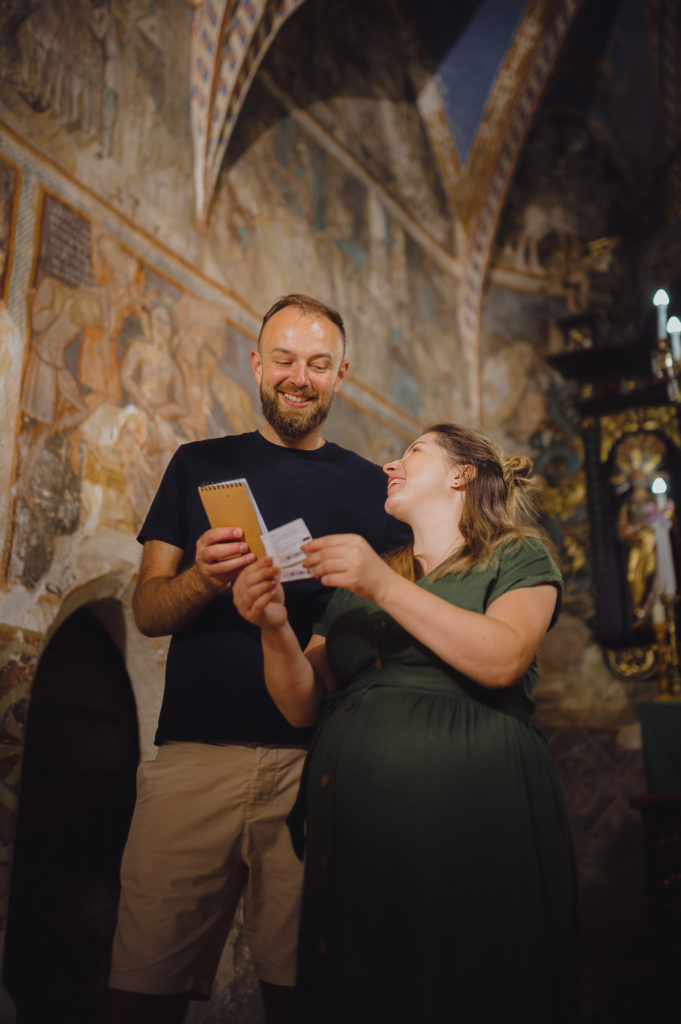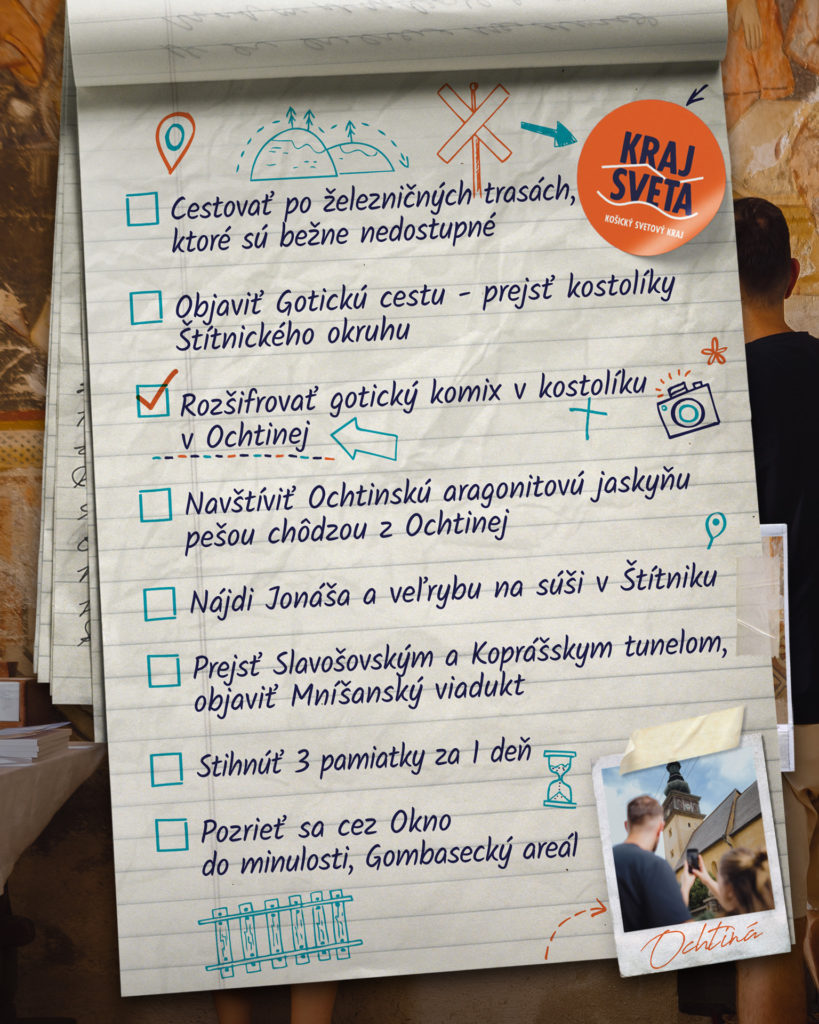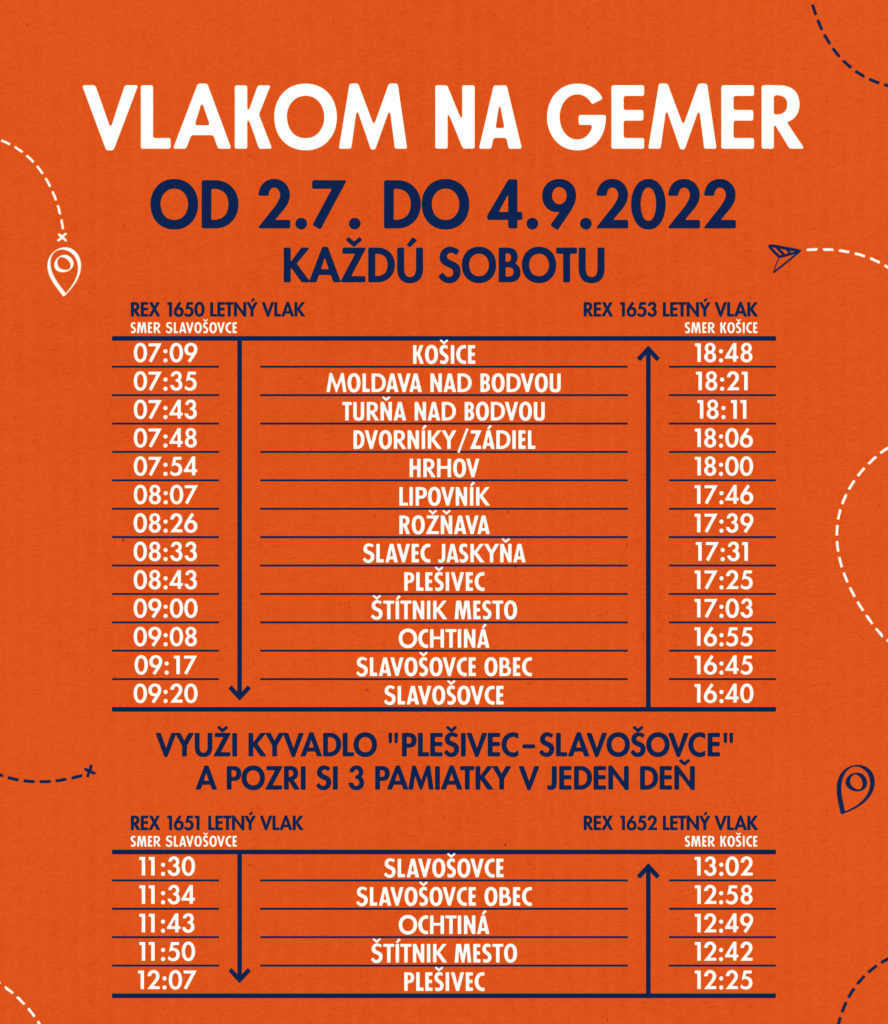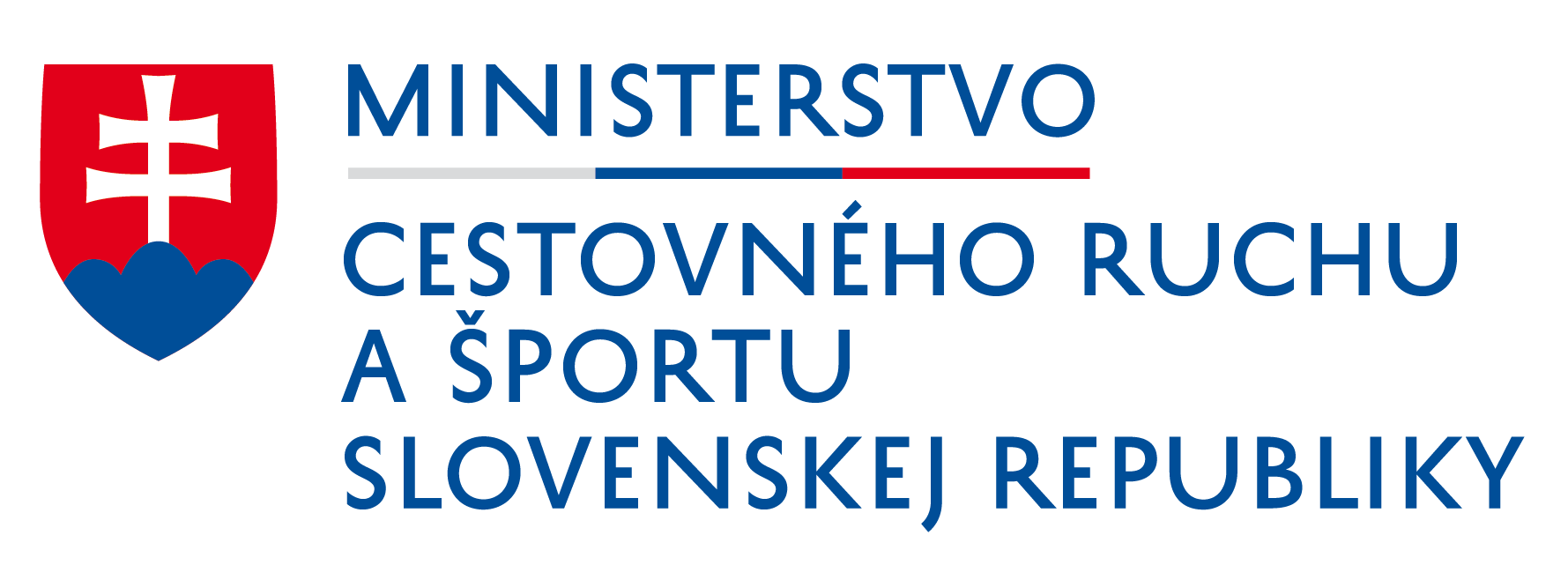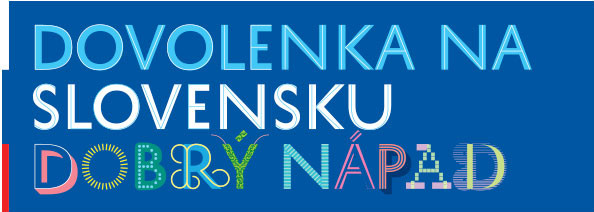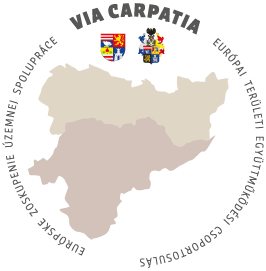
1. Travelling on rail routes that are usually inaccessible
Special summer tourist trains
It’s here at last! Finally, there is an opportunity here to travel along the famous route to Slavošovce! You may now reach the places previously inaccessible by your own foot. Well, yes, first on the wheels of the train, which now has the privilege of stepping into those magical places and bringing you here. According to historical records, in the 12th century, an unreachable knight with the same name of Gumur resided here in the not commonly accessible castle of Gumur. He himself knew best that this region would one day abound in unique natural wealth. The nature of the landscape is mainly determined by the largest karst area in Slovakia – the Slovak Karst National Park and its gorges, caves, and scarp, but also cultural and historical wealth.
More information on summer tourist trains HERE.


2. Discover the Gothic route – pass the churches of the Štítnik circuit
Plešivec, Štítnik, Koceľovce, Ochtiná
The Gothic tourist sightseeing route presents the most interesting and rare gems of Spiš and Gemer in a comprehensive circuit, which in their importance far exceed the framework of the region and Slovakia and are an inseparable part of European cultural life. Walk along the picturesque paths of the Gothic Route, from which you will marvel at the centuries-old Gothic style in the buildings and on their walls.
Plešivec. No baldness on the walls, quite the opposite! The Plešivec paintings really belong to the most important wall-painting artifacts of the 14th century Alpine painting. Today, they are only partially exposed frescoes, but they are among the most valuable medieval wall paintings in Slovakia and at the same time the most important artifact of wall painting of the 14th century. During the restoration of the Plešivec church in 1938 by the Hungarian Historical Institute, a painting depicting the two holy Hungarian kings, Stephan and Imrich, on the southern facade and a figure of the saint in the southeastern corner of the presbytery, were uncovered. In 1977-1978, the paintings on the southern wall of the presbytery were discovered and restored. They are two scenes in two bands one above the other: in the upper band only a fragment of the Last Supper preserved and below it a monumental scene of the Crucifixion including two crucified thieves, with three Marys and St. John, a group of Pharisees, soldiers on horses, and other characters. In addition to the monumentality of the scene, the depiction of some details, especially the faces of the Pharisees and St. John, while the painter quite unconventionally placed the symbol of the evangelist Mark – the head of a lion among the crowd gathered under the cross. The mastery of a brilliant painter’s shorthand when depicting the body of a rogue in a pre-death convulsion at Christ’s right is also astonishing. The method of creating plastic halos using wooden pegs is also characteristic of Italian painting of the first half of the thirteenth century.
Štítnik. Take your protective shield, because you will be attacked by so much incredible beauty that you will have trouble resisting the onslaught of the outstanding fresco decoration of the small church in Štítnik. Its history dates back to the beginning of the 14th century. It was conceived relatively generously since its inception as a Gothic three-nave basilica built on the site of an older church. The fresco decoration in this church represents, of an area of approximately 200 m2, the most extensive preserved example of medieval wall painting in Slovakia. A well-preserved and still used 500-year-old organ is part of the interior equipment. The church currently serves as a parish church for the Evangelical Church choir, and in addition to religious services, various concerts of historical music are often held here.
Koceľovce. Stunned by the Gothic splendor, come and harden yourself in the next church – in Koceľovce. One more big pat on the soul. The entire presbytery is covered by frescoes from 1360-1380. It is one of the most complete Gothic paintings in Slovakia. Paintings are almost everywhere. They represent by far the largest continuous painted area among all of the Gemer churches. They are characterised by a plain to narrative delivery with a marked linearity and unusual compactness of action. The individual scenes are spread over the entire surface of the perimeter walls and vaults of the presbytery in three horizontal strips above each other. In the individual paintings, you can feel that there was enormous wealth in this region in the past. Now this place exudes a wealth of emotions from art that will conquer you fully.
More information HERE.
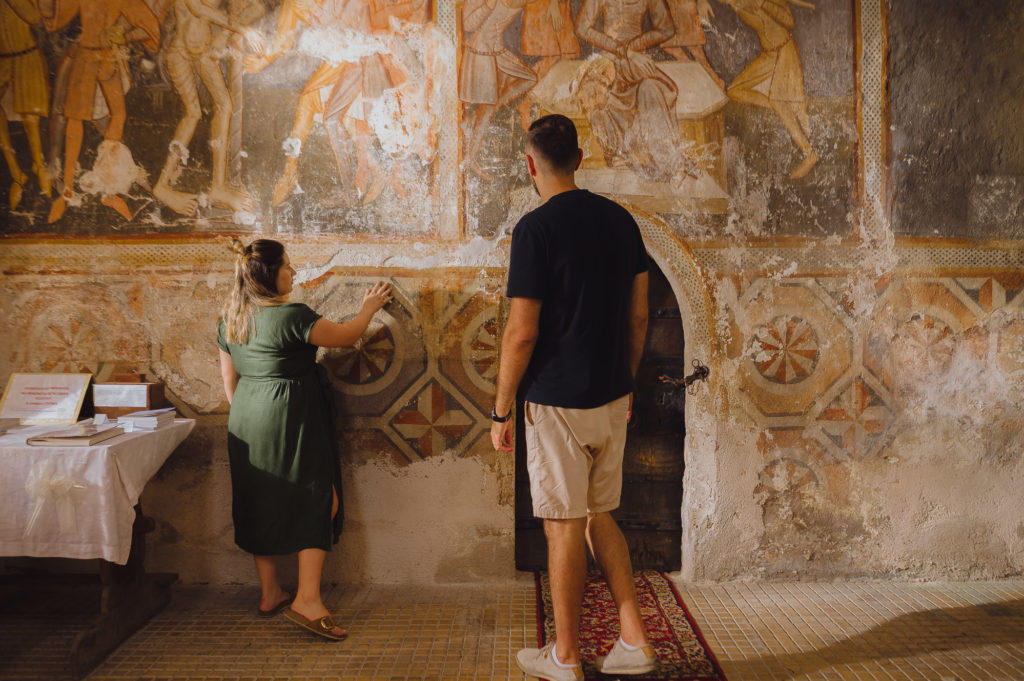
3. Decipher the Gothic comics in the church in Ochtiná
Ochtiná
After your morning “three-in-one” coffee, you may start exploring, where your caffeine will really come in handy. Three heads of one god is a big challenge. In a way, this symbol of the three-headed god triglav remained defeated almost like a three-headed dragon, but the divinity of the triune God of Christianity lives here and continues to waft through the air under the wings of a dove as the Holy Spirit. In the arch of the rose window at the end of the presbytery, there is an archaic depiction of the Holy Trinity in a circular medallion in the form of one head with three faces (a similar depiction is known in this country only from the Church of the Holy Spirit in Žehra in Spiš and from the Church of the Holy Trinity in Rákoš, Gemer). This depiction was used until the Council of Trent (1545-1563). Regarding it as an ancient medieval symbol, it was chosen as the logo of the church and Gemer Gothic Route.
Another mega batch of valuable frescoes! The Evangelical Church in Ochtiná has elements of the Romanesque, Gothic and Baroque styles with beautiful frescoes in the interior. It is among the oldest and most interesting landmarks of the Gemer countryside. Around the mid-14th century, the Ochtiná church was painted with figurative wall paintings using the fresco technique. At the beginning of the 16th century, the relatively small space of the church was expanded with a northern side nave covered by a star vault. In the first third of the 17th century, when the church was already Evangelical, the medieval wall paintings were whitewashed, and in the course of the 18th century, the nave was re-roofed with Prussian vaults. Gothic murals cover the entire inner shell of the presbytery and are preserved fragmentarily in the attic space. Only a few fragments of younger Renaissance ornamentation can be seen on the southern wall of the nave, under which a more continuous layer of paintings may be assumed. The Last Supper is one of the most impressive frescoes in Ochtiná, which impresses one not just by its colour, but also with a certain intimacy of the narrative, which culminates in the following scene, Prayer in the Garden of Gethsemane.
More information HERE.
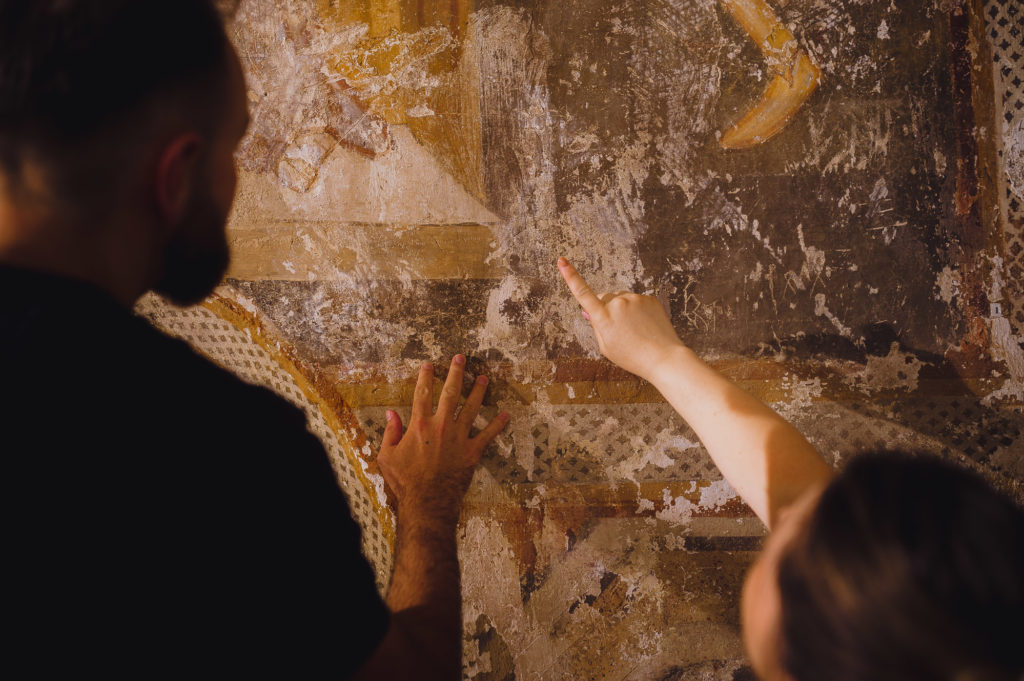
4. Visiting the Ochtiná Aragonite Cave on foot from Ochtiná (1 of 3 accessible caves of its kind in the world)
Ochtiná Aragonite Cave
“Ocht”, the Old German expression for the number eight, became the trigger for the creation of the name of the village Ochtiná. In the second half of the 13th century, this locality was inhabited by eight German families – “guests”. Now follow the path of the original eight German families, who founded a prosperous settlement here based on the mining of iron ore located in the nearby Hrádok hill, and go down to the underground realm of Ochtiná, even deeper into history, to the depths of underground beauty, tear off a flower, the rarest form of aragonite called iron flower, resembling coral. This world treasure was discovered by complete incident in 1954 while digging a geological survey tunnel. It was opened to the public in 1972. In the access tunnel of the Ochtiná Aragonite Cave, you have to climb 104 steps and then just enter the world of beauty that only the almighty mother nature could create. It is a world unique for tiny Slovakia, as the cave is one of the three accessible aragonite caves on the planet. The remaining two are in Mexico and Argentina. Of the total length of 300 metres, 230 of them are accessible and the tour lasts half an hour. According to metric data, it is not a large cave, but it is extremely valuable. The colourful aragonite filling in the form of spirals, needles and coral-like formations creates a diverse mixture of beautiful images. The Hall of the Milky Way is considered to be the most beautiful place in the cave, where white aragonite fringes in a crack in the ceiling create the impression of the stars of our galaxy in the light of lamps.
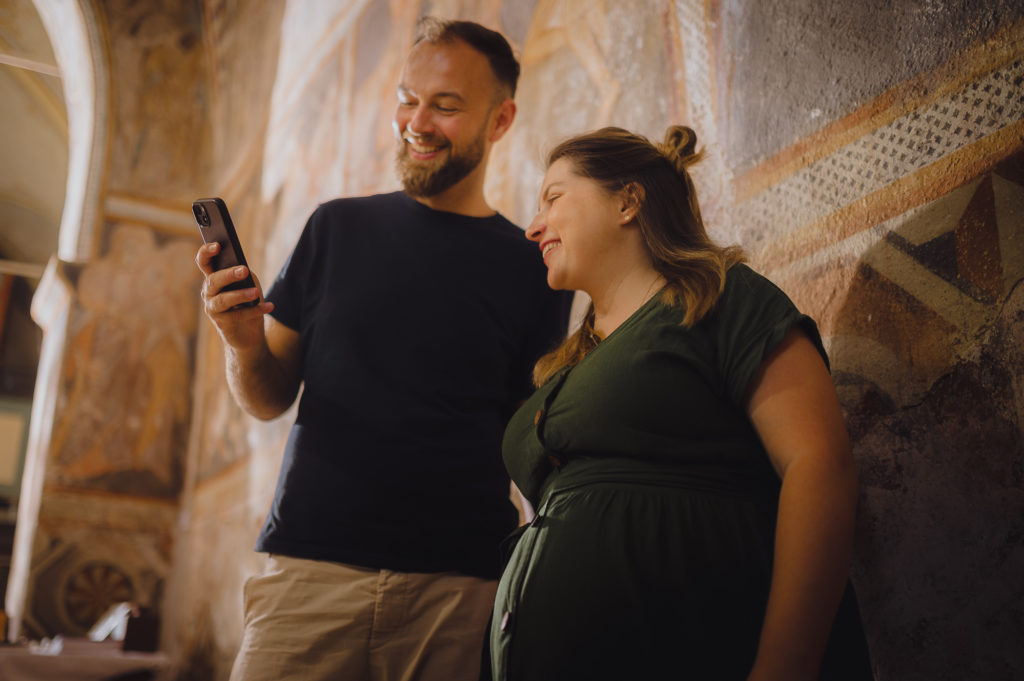
5. Find Jonah and the whale on land in Štítnik
Štítnik
The dominant church on the square in Štítnik is decorated with Gothic frescoes that will leave you standing in awe. It’s an incredible feeling. A person quite suddenly and completely unexpectedly leaves the 21st century and kind of dives through a time gate into the Middle Ages. Admire the apocalyptic scenes, the white riders on horseback, Saint Bartholomew with red paint and a skin pulled over his shoulders on the oldest Gothic on the east wall of the nave. It is here that the true fresco technique, typical for Italy, is used. An interesting scene from the Old Testament legend about Jonah and the Whale may be found in the Štítnik church artistically processed several times: in the form of a relief in the extension of the main altar, as a panel painting on one of the epitaphs and also as a small scene in the frescoes. Because of this trinity of motifs, Jonah is in the logo of the church. And so that we don’t remain at the Biblical three, not even the Biblical seven may be ashamed in Štítnik. Look at the Gothic window. Those circles symbolise the secular motif of the seven liberal arts, the so-called Septem Artes Liberales. You will find logic, arithmetic, grammar, rhetoric, astronomy or music there. To see something similar among Biblical motifs is an absolute rarity. The second such display can only be found in the city of Lucca in the south of Italy.
More information HERE.
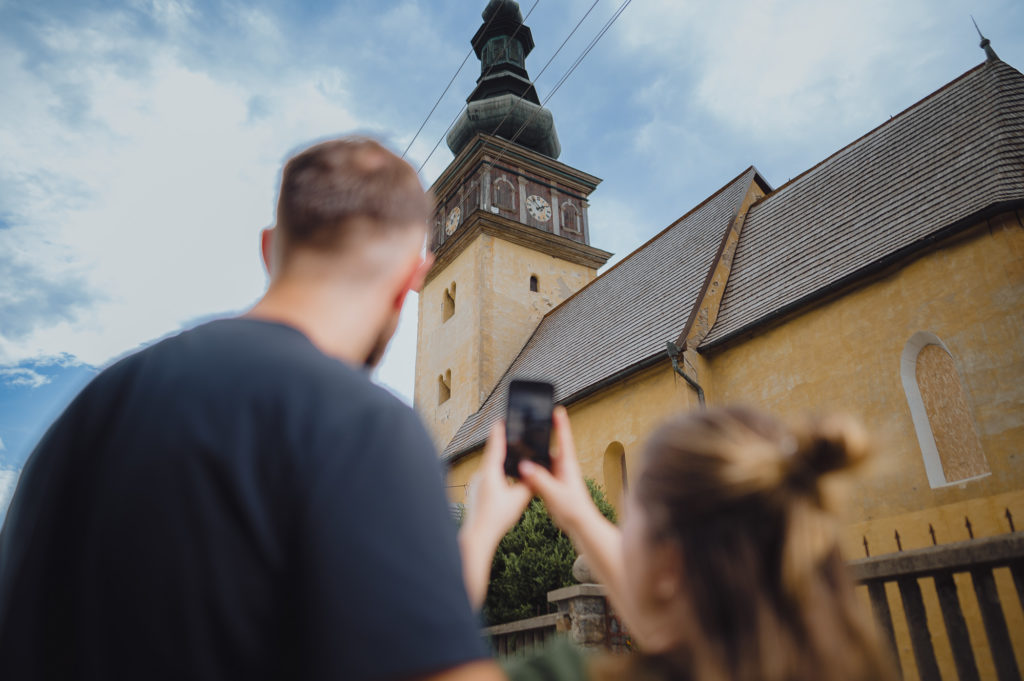
6. Passing through the Slavošovce and the Kopráš tunnels
Slavošovce tunnel
Only the railway guard of the historical secrets of the rails can get here. The guard hides them in the darkness of the tunnels, and today you have the opportunity to pass through the absolute darkness, in which her great secrets will shine. A walk through the tunnel has its own mysterious charm and its own history. The Slavošovce Tunnel under Homôlka together with the nearby Kopráš Tunnel and Viaduct are the places where a powerful experience awaits you. They are abandoned railway tunnels through which no train has ever passed. However, they are publicly accessible and hide an unforgettable crossing experience. There is magical darkness, cool dampness and total silence. Illuminate the secrets of dark tunnels with a headlamp or flashlight. Brave visitors describe visiting the tunnel as a strong adrenaline experience. It is a truly extraordinary feeling that is worth it! The Slavošovc Tunnel is 2.4 km long and 6 m high. It connects Slavošovce and Magnezitovce and was never put into operation. It began to be built during the World War II in 1941. It was ceremonially passed through in the spring of 1944. Constructing the tunnel lost its importance with the end of the war and the approaching Slovak National Uprising. In the end, the tunnel has never been used. Construction of the Kopráš Tunnel began in March 1941. Despite transport and supply difficulties, it only lasted a few months. As early as 11 August 1941, a celebration could be held at the construction site of the tunnel, whose directional deviation was not greater than 1 millimeter, and it is also rare that the excavation of the directional tunnel was completed without injury. Compared to its more famous Slavošovce neighbour, the Kopráš Tunnel is much shorter (its length does not even reach 250 m), but it is possible to pass through it even without artificial lighting. It mouths in the form of a viaduct, which, however, remained unfinished. The viaduct towering over the surrounding picturesque landscape is 38 metres high and 120 metres long.
More information HERE.
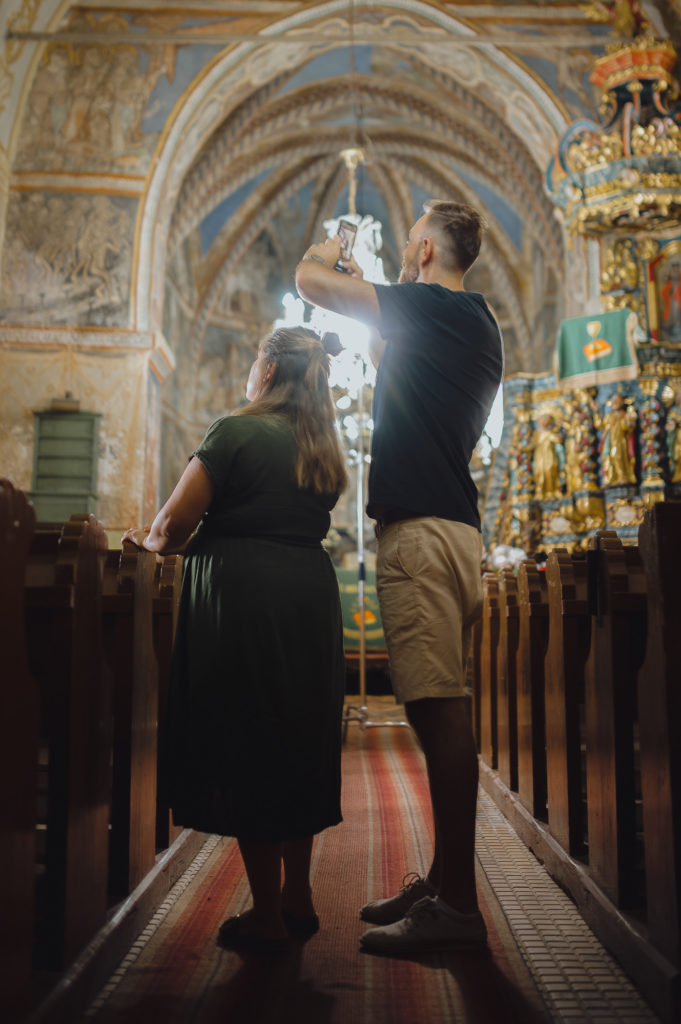
7. Looking through the Window into the past, the Gombasek area
The Gombasek area
Open the window of your soul, let in a pleasant breath of history and art stretching through Gombasek. This place is a divine gateway to the Slovak Karst, the forgotten Gemer Mountains, whose reputation is reviving right in front of your eyes. Breathing to you the freshness of the photosynthesis of the past from the trees of the Andrássy era, the blackberry, which was a modern fruit in the era of Maria Theresa. There is an infectious calm everywhere. Various natural attractions such as sinkholes, chasms, hot springs, caves and rare fauna and flora may be found in the surroundings of the resort. The Gombasek area offers various attractions. Here you can look into the past through a special window, walk along the educational trail, climb the observation tower or learn about the history of the Pauline Monastery. Let yourself be surrounded by the underground beauty of the Gombasek Cave. This is where the stone rain falls. Well, don’t close the window, just enjoy the view of everything that the Gombasek area has to offer.
